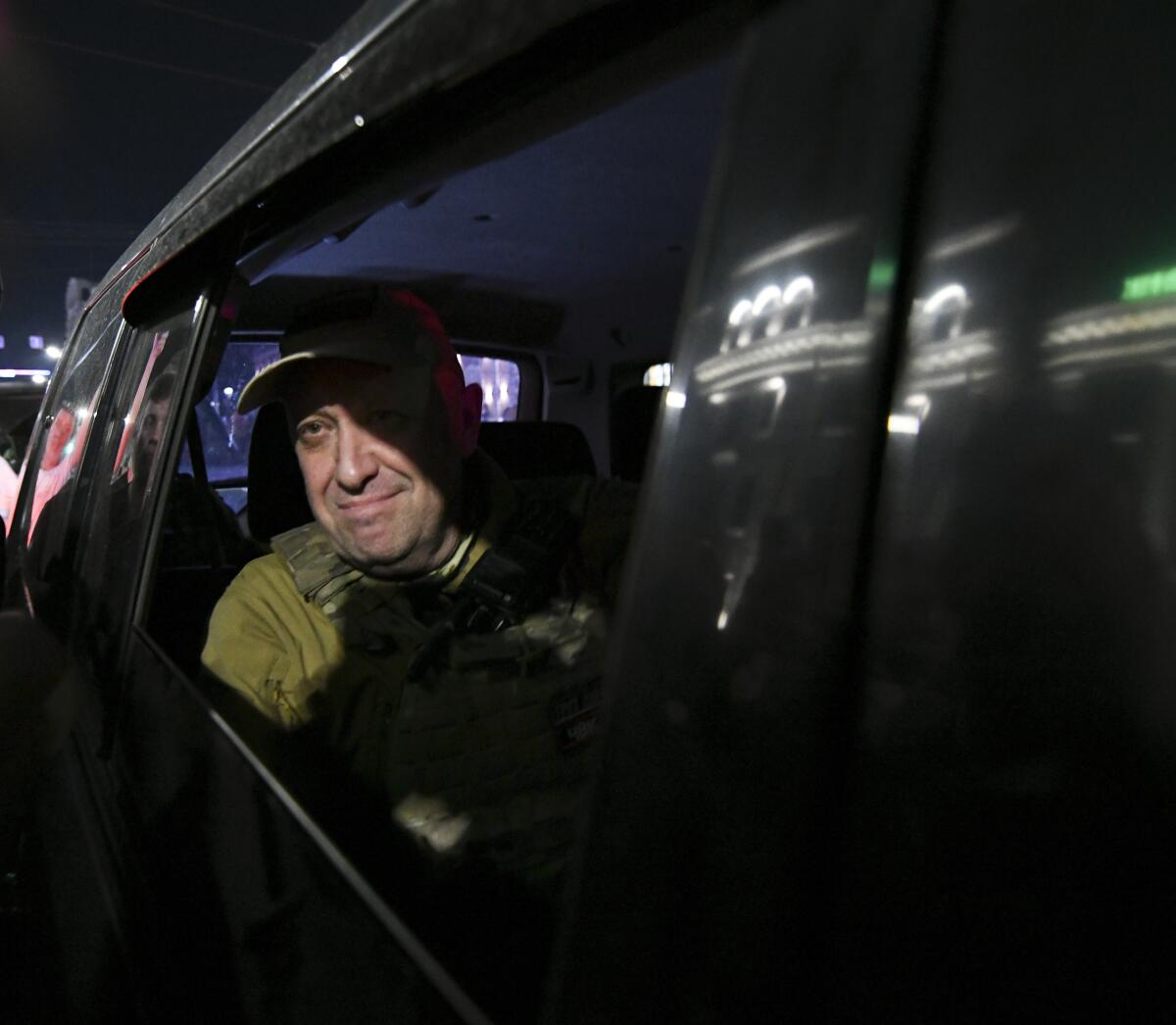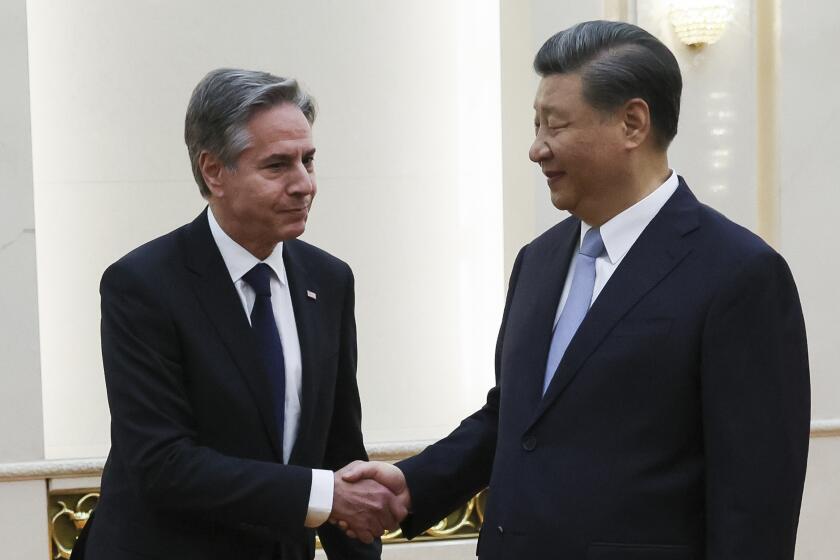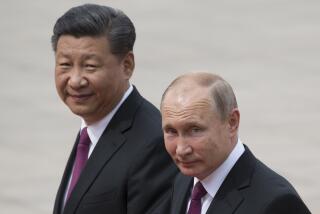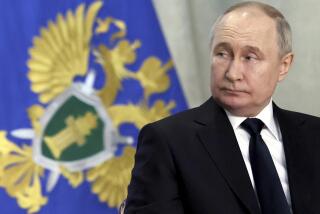Column: Bizarre standoff with Wagner Group’s Prigozhin weakens Putin. But don’t count him out

- Share via
WASHINGTON — A little more than a week ago, Russian President Vladimir Putin’s hold on power appeared to be disintegrating. Rebel mercenaries were advancing on Moscow against little or no resistance. Wealthy Muscovites scrambled for tickets out of the country. A coup d’etat attempt seemed imminent.
And then, a perplexing reversal. After denouncing the mutiny as “treason,” Putin agreed to allow its leader, Yevgeny Prigozhin, to take exile in neighboring Belarus. Prigozhin, presumably realizing his mercenaries couldn’t conquer Moscow without help from regular army units, submitted.
Putin, once seen as an all-powerful autocrat, seemed to have suffered a humiliating blow to his authority.
But don’t count Putin out — not yet, anyway.
That’s what a growing number of Russia experts said last week as the dust settled and a modicum of perspective set in.
“Putin faces a lot of problems, to be sure,” said Stephen Sestanovich, a professor of international diplomacy at Columbia University. “But it looks as if he’s still got most of the assets he needs to address them.”
“People would like to find new evidence that Putin is vulnerable, but it may be overstated,” warned Andrew S. Weiss of the Carnegie Endowment for International Peace. “The power of wishful thinking.”
It’s a conservative Supreme Court, but not quite as predictably so this year, as several surprise rulings have shown.
These Russia scholars aren’t defending Putin, the brutality of his regime or his catastrophic decision to invade Ukraine.
“There’s no better argument for term limits than Vladimir Putin,” Sestanovich said.
They’re merely noting that he has survived tough challenges before, and that after 23 years in power, he’s unlikely to collapse without a fight.
Much of what happened in the bizarre standoff with Prigozhin remains murky. The boss of the Wagner Group, a so-called private military company, was rebelling against Putin’s order that he subject his mercenaries to the command of the regular armed forces.
The Wall Street Journal has reported that Prigozhin intended to kidnap the Russian defense minister and army chief of staff to press his case. Prigozhin may also have expected other military officers to rally to his side; when that didn’t happen, he recognized his cause was lost.
The deeper mystery is why Putin’s intelligence services apparently didn’t warn him of the plot and why other military units failed to block the mercenaries’ march on Moscow.
This isn’t the first time the Biden administration has tried to build a floor under the relationship between U.S. and China, and it probably won’t be the last.
By the time Prigozhin’s men were within 125 miles of the capital, “Putin was staring down the barrel of a gun,” Sestanovich said. “He had an overriding goal, which was to avoid shooting in the streets of Moscow. That would have been vivid proof that he had failed.”
“Putin’s brand is stability,” Sestanovich explained. “What he needs above all is to convey normalcy … [and] a sense that he is back in charge.”
Once the outcome was clear, officials in Moscow rushed to declare loyalty to Putin. Russia’s military and intelligence services launched investigations to determine what went wrong. Gen. Sergei Surovikin, the air force commander who is close to Prigozhin, is reportedly being interrogated.
Meanwhile, Putin has launched a charm offensive, staging a sudden flurry of public appearances after three years of seclusion during the COVID-19 pandemic. His propaganda machine is downplaying the mutiny.
It’s even possible, Sestanovich said, that the mutiny has shocked Putin into recognizing that he had lost touch with his country’s politics.
“This has been a kind of wake-up heart attack for him,” Sestanovich suggested. “He needs to make everybody feel that they’re still benefiting from his regime — a pretty tough challenge.”
Meanwhile, his war against Ukraine has continued unabated. The high-level turmoil in Moscow had no discernible effect on the battlefields to the south. Russian units continued to defend the Ukrainian territory they have occupied behind a fearsome system of minefields and tank traps called the “Surovikin line” — ironically, it was built by the general under interrogation. No units were reported to have deserted or defected.
If anything, the episode appeared likely to secure the jobs of Prigozhin’s main targets, Defense Minister Sergei Shoigu and army chief of staff Gen. Valery Gerasimov, even though both have been widely criticized as incompetent.
Another sign of normalcy, Putin-style: The Wagner organization’s recruiting office in Moscow, which closed briefly during the mutiny, reopened and told callers it was accepting new applicants, according to the BBC and Russian media outlets.
That suggests that Putin has decided not to disband Wagner, which has not only been more brutal on the battlefield than the regular army, but also more successful at attracting recruits, partly because it pays higher wages.
If Wagner were to disappear, Putin’s war machine could lose as many as 15,000 of its most experienced fighters.
Some Western officials have expressed impatience that Ukraine’s offensive isn’t moving faster. Ukrainian President Volodymyr Zelensky has acknowledged that progress has been “slower than desired.”
But Ukrainian officers have noted that finding weak spots in Russian defenses will take time, and that the fighting season runs until November.
There’s not much the United States and its allies can do to affect Putin’s fate in Moscow — except, perhaps, stay out of the way.
But they can keep military and economic aid flowing to Ukraine to increase its chances of success.
Putin isn’t likely to fall anytime soon, but he’s still more vulnerable than he was before the mutiny. This is no time to give him any breathing room.
More to Read
Get the L.A. Times Politics newsletter
Deeply reported insights into legislation, politics and policy from Sacramento, Washington and beyond. In your inbox three times per week.
You may occasionally receive promotional content from the Los Angeles Times.













